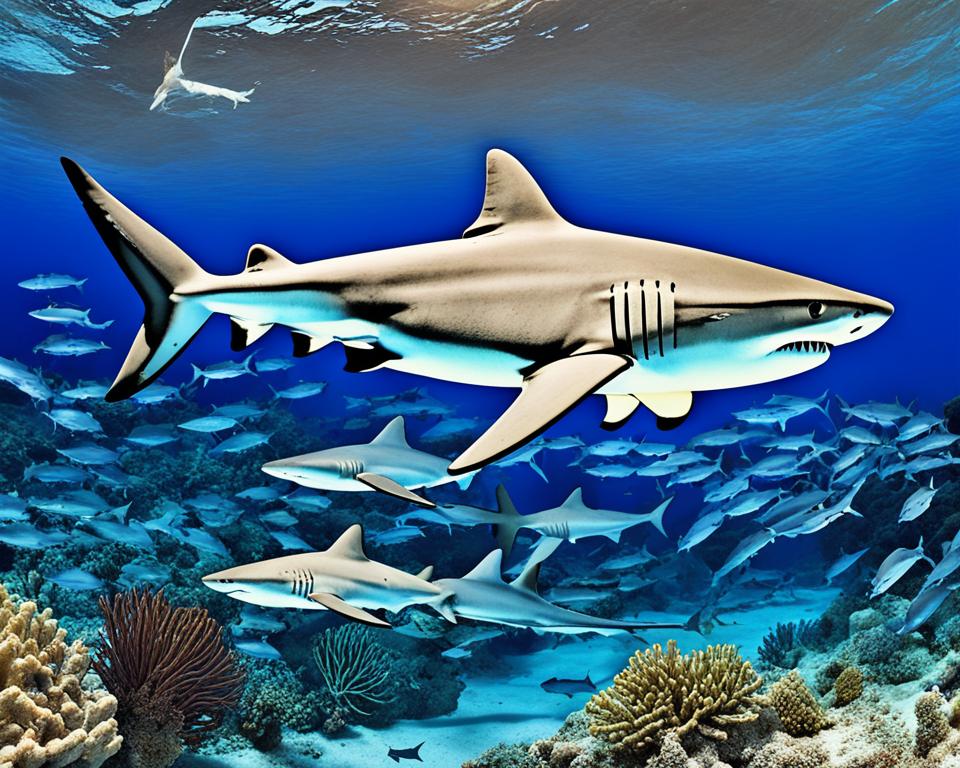Imagine diving into the warm, crystal-clear waters where the wonders of the ocean ecosystem unfold before your eyes. Among the vibrant marine life, you might chance upon one of nature’s most robust tropical predators—the bull shark. These aggressive sharks, known for their stocky build and blunt snout, are a compelling topic for anyone intrigued by the undersea realm. As you delve into bull shark facts, you’ll discover that despite their notoriety, bull sharks play a crucial role in balancing the marine biosphere.
Your curiosity might have been piqued by stories of their fierce nature, but there’s much more to these shark species than meets the eye. Embark on a journey with us through the ocean’s depths, where these creatures patrol the coastal margins, and explore the intricate dynamics of their existence within the vast ocean ecosystem. It’s an encounter with one of the underwater world’s most enigmatic inhabitants that you won’t want to miss.
Bull Sharks: Masters of Sea and River
Embark on a journey into the diverse realm of coastal predators where the bull shark reigns as a surprising connoisseur of both saltwater and freshwater habitats. These formidable creatures are not restrained by the saline boundaries of the ocean, thanks to their remarkable saltwater adaptation. Curious to learn how these predators traverse from the gleaming coastal waters to the murky bends of rivers? Let’s delve into the world of shark migration and uncover the secrets of their incredible journey.
Unlike many of their kin, bull sharks possess an extraordinary biological mechanism that allows them to thrive in both saline oceans and the freshwater depths. Whether they’re navigating the vast currents of the Mississippi River or the distant, winding paths of the Amazon, they exhibit an uncanny ability to adjust internally. This capacity for osmoregulation takes them on epic voyages, with some navigating nearly 2,200 miles against the flow to remote waters of Iquitos, Peru.
Your adventure into the world of bull sharks continues as you explore the waterways where they’ve established their presence—witness their flexibility in selecting freshwater habitats such as the Brisbane River in Australia or the sacred Ganges of eastern India. Even bodies of water like Lake Nicaragua and Lake Pontchartrain have seen these daring migratory predators. It’s not just about survival but rather an assertive claim over diverse territories both saline and fresh, showcasing their adaptability as apex coastal predators.
Now, imagine standing by a riverbank or peering into a lake never knowing that beneath the surface could be one of nature’s most incredibly adapted creatures—a testament to the intricate evolutionary forces that shape our planet’s biological diversity. Bull sharks, with their astounding ability to partake in both saltwater adaptation and shark migration, remind us that the wonders of the animal kingdom are boundlessly fascinating. They traverse from sea to river not just to survive, but to thrive in environments both foreign and familiar.
The Robust Design of Bull Sharks
As you delve deeper into the wonders of marine biology, you encounter the uniquely designed bull shark appearance, a formidable figure in the aquatic food chain. With a body that’s wide compared to its length, these powerful predators have an anatomy that sets them apart within the shark world—imbuing them with both a visual and tactical edge. Before analyzing the standout aspects of their physique, take a moment to visualize their robust form, gliding through the waters, a blend of power and grace.
Stocky Predators with a Unique Build
The physical form of bull sharks makes them distinctive figures of marine prowess. Let’s pry into the dimensions of shark anatomy that make the bull shark both fascinating and intimidating. Their stout build not only contributes to their recognizable silhouette but also to their efficiency as predators. The dark topside of their skin merges with the ocean depths when seen from above, while their lighter underside blends seamlessly against the bright surface when viewed from the depths—perfect natural camouflage in their predatory pursuits.
Discreetly Powerful Bite
Now shift your focus to one of the most awe-inspiring aspects of the bull shark—their impressively powerful bite. With a bite force surpassing many of its peers, bull sharks command respect with their potent jaws. This capability is a testament to their status as one of the ocean’s most powerful predators, able to exert immense force that bolsters their formidable reputation. A weighty combination of musculature and leverage gives them a jaw-dropping advantage over their pray and occasionally, their competitors.
It’s worth framing the might of their bite in the comparative scope of marine biology:
| Species | Maximum Bite Force (Newtons) |
|---|---|
| Bull Shark (Carcharhinus leucas) | 5,914 |
| Great White Shark (Carcharodon carcharias) | 1,800 to 4,000 (estimate) |
| Great Hammerhead (Sphyrna mokarran) | Data Unavailable |
This snapshot of their biting capabilities highlights not just the prowess they possess but the predominant role bull sharks play as top-tier predators in their marine ecosystems.
Understanding Bull Shark Behavior
Delve into the world of the formidable bull shark, a species notorious for its shark aggression and remarkable adaptability. These marine predators possess traits that both fascinate and intimidate. With a bull shark diet that includes a wide range of aquatic life and an unexpected tendency to roam freshwater systems, their behavior offers invaluable insights into the complexities of animal behavior. As you become familiar with their habits, you gain a unique perspective on the essential role these sharks play within their ecosystems.
Aggressive Reputation with a Nutritionally Diverse Diet
The bull shark’s reputation as an aggressive species is often highlighted in discussions of animal behavior. This character trait is largely attributed to their broad and opportunistic feeding habits that span various prey. Their diverse diet comprises not only bony fish and smaller sharks but also extends to birds, dolphins, and crustaceans—indeed, a broad menu that emboldens their status within the marine food web. These predators display a remarkable degree of dietary flexibility, emphasizing their role as adaptable marine predators.
Why Bull Sharks Frequent Freshwater
The choice of freshwater habitats by bull sharks is a subject of fascination and extensive study. Unlike many sharks, bull sharks often inhabit freshwater areas, which has implications for their reproductive strategies. Seeking safer conditions for their young well away from the saltwater realms where other predatory sharks reside, they exploit these environments as nurseries. This insightful behavior not only provides a shield for their offspring but also exemplifies the strategic adaptability of bull sharks as they navigate the diverse aquatic landscapes of our planet.
A Deep Dive into Bull Shark Habitats
Discover the extraordinary bull shark distribution across our planet’s waters. These enigmatic creatures have a captivating presence within diverse marine environments, reflecting their evolutionary success and behavioral adaptability. You might picture these apex predators prowling the tropical coastline, yet they also navigate the riverine labyrinth stretching deep into continents. Join us as we explore the habitat preferences of these remarkable sharks, crucial for their conservation and understanding of marine ecology.

Their ability to reside in both sea and freshwater systems positions bull sharks as unique participants in marine environments. This capacity for ecological duality has led to a fascinating pattern of bull shark distribution, which encompasses a vast geographic range from coastal estuaries to the furthest upstream reaches of rivers. It is this distinction in habitat preferences that challenges our perceptions of sharks as solely ocean-bound creatures.
With a remarkable global reach, bull sharks’ habitats span continents and climates. They familiarize themselves with local food sources, adjust to varying salinity levels, and use these habitats to their reproductive advantage. Here’s a snippet of global spots where these adaptable sharks make their impressive mark:
| Region | Habitat | Notable Observations |
|---|---|---|
| Australia | Brisbane River | Populated areas with high shark presence |
| Americas | Mississippi River, Lake Pontchartrain | Migration upstream for hundreds of miles |
| India | Ganges River | Reproduction in sacred freshwater systems |
| Central America | Lake Nicaragua | Seemingly landlocked population thriving in freshwater |
Understanding the nuances of bull shark habitats is indispensable for their preservation. The conservational efforts hinge on the rich tapestry of their life cycle, which in turn is deeply entwined with their chosen environments. Your journey into the world of bull sharks reveals the mysteriously winding paths they take—a testament to the grandeur and diversity of life beneath the water’s surface.
Impressive Bull Shark Adaptations
As you wade into the depths of understanding the bull shark’s remarkable existence, you are confronted with their exceptional ability to conform to different water conditions. These predators are known for their aquatic adaptability, allowing them to dominate both saltwater and freshwater ecosystems with relative ease. The bull shark’s physiology is a marvel of nature, equipped with complex systems that ensure their survival across diverse habitats. Now, let’s examine the two key features that grant these sharks such environmental versatility.
Osmoregulation: Salty or Fresh, They Thrive
The science behind bull shark osmoregulation is genuinely fascinating. It’s this process that allows bull sharks to maintain a stable balance between the salts in their bodies and the water they inhabit—whether the salinity levels are high in the ocean or practically non-existent in rivers and lakes. The role their kidneys, liver, and rectal glands play is pivotal, subtly adjusting to ensure their internal environment remains in harmony with their surroundings. This freshwater adaptation gives them the edge to explore territories few other sharks can.
Global Travelers: Bull Sharks in Lakes and Rivers
Bull sharks don’t just frequent the ocean; they are global travelers, venturing boldly into freshwater systems where they have been known to reproduce and establish significant populations. This unique capability of freshwater adaptation is not just a trivial feat but represents a crucial aspect of their life cycle and existence. Sightings of bull sharks far upriver are testament to their staggering endurance and adaptability—traits that continue to intrigue and bewilder scientists to this day.
In summary, the combination of bull shark osmoregulation, aquatic adaptability, and their penchant for both freshwater and marine environments, not only make bull sharks a subject of great scientific interest but also of conservation. They remind us of the intricate connections within ecosystems and the importance of preserving our planet’s diverse aquatic habitats.
The Mysterious Diet of Bull Sharks
As you plunge into the undercurrents of aquatic predation, you’ll uncover the enigmatic world of bull shark feeding habits. Known for their diverse palate, bull sharks display a fascinating variety of dietary choices that secure their apex position in the food chain. These predators are not picky eaters; their wide-ranging appetite includes everything from the tiniest fish to the mightiest dolphins.
https://www.youtube.com/watch?v=I3pJlzPRX9Y
Amidst the vastness of the ocean, the bull shark’s powerful bite reveals a story of survival and domination. The force exerted during their bite is so immense it can crush mollusks and even sea turtles with ease. Yet, their dietary strategy extends beyond sheer force; bull sharks are strategic in their consumption, employing impressive control over their digestive pace.
Let’s take a closer look at the shark diet diversity:
- Fish – The staple of their diet.
- Marine mammals – Including sea turtles and dolphins.
- Invertebrates – Such as crabs, lobsters, and squid.
- Other sharks – Demonstrating their dominance in the marine hierarchy.
An extraordinary feature of bull sharks is their ability to slow down or speed up digestion based on the availability of food. This level of physiological control shows adaptation at its finest—when prey is scarce, they conserve energy; when it’s abundant, they capitalize on the opportunity.
The bull shark’s feeding strategy also includes a unique escape mechanism. In the face of a threat, they can regurgitate their meal to distract predators, ensuring their own safety. This remarkable adaptation further emphasizes the bull shark’s mastery of aquatic predation—an embodiment of resilience and power in the marine realm where they both fear and are feared.
Understanding the bull shark’s feeding habits offers a glimpse into the complex dynamics that govern life under the sea. It reveals the intricate balance between predator and prey, the delicate dance of the marine food web, and the marvel of evolutionary design that allows such an adaptable predator to thrive in various environments.
Peculiar Reproduction of the Bull Shark
Delving into the reproductive mechanisms of the viviparous bull shark reveals a process distinctly different from their egg-laying counterparts. With shark mating habits that culminate in live birth, these creatures stand apart as maternal curators of the next shark generation, ensuring that their lineage thrives in both fresh and saline waters. Witness the marvel of bull shark reproduction as it unfolds within diverse aquatic environments.
Birthing Live Pups
Gone are the brittle eggs of oceanic floor nesting; viviparous sharks like the bull shark embrace a more direct form of procreation. Bull sharks engage in internal fertilization, after which they nurture their developing pups for an extended gestation period, typically 11 months. This generous timespan allows the embryos to mature fully before the females venture into estuaries or river mouths to deliver their young in safer, placid waters. This strategic choice of birthing location safeguards the newly born pups from oceanic predators, increasing their chances of survival in their formative days.
The Journey from Fresh to Salt Water As They Grow
Today’s pup cradled in the tender brackishness of the river mouth will tomorrow navigate the vastness of the open ocean. As the young bull sharks mature, they embark on a significant transition—moving from the nurturing freshwater havens of their birth to the richer and more challenging marine ecosystems. Their biological design allows this seamless transition back into saltwater. It is within these salty realms that they will develop into the imposing adults that command respect across the seven seas.
The pack-like tendencies of shark mating habits, coupled with the extended gestation and strategic birthing choices of mothers, stand testament to the bull sharks’ robust lifecycle. Reflect on the sophistication with which these creatures preserve and adapt to their lineage—a story of both vulnerability and tenacity.
Bull Sharks Through the Lens of History
The annals of historic shark attacks are marred with chilling tales of unexpected encounters between humans and sharks, often casting these ocean dwellers in a shadow of infamy and fear. Within this storied history, the bull shark has carved its name, not just through recorded incidents, but also through its distinct presence in pop culture sharks narratives.
Among the many brushes between sharks and humans, few have captured the public’s imagination quite like the grievous events of the 1916 New Jersey shore attacks. These attacks, which tragically claimed the lives of several individuals, lie at the heart of the bull shark’s notorious reputation—fueling speculation that has persisted for over a century.

Albeit a great white shark was vilified in Peter Benchley’s gripping novel “Jaws” and its subsequent cinematic rendition by Steven Spielberg, the characteristics of the 1916 attacks have led some experts to surmise that a bull shark may have been the true assailant. The predilection of these predators for freshwater ecosystems where some of the attacks occurred would support such a theory.
While fear of these creatures has been amplified due to bull shark infamy, their depiction in media has often overshadowed the complex nature of their interactions with humans. Below, you will find a comparative analysis of shark attacks by species, underlining the prevalence of such incidents against the backdrop of their representation in media and culture.
| Shark Species | Number of Documented Attacks | Cultural Impact |
|---|---|---|
| Great White Shark | 354 | Widely recognized as the quintessential “man-eater” from “Jaws” |
| Tiger Shark | 138 | Known for its role in numerous attack stories across tropical waters |
| Bull Shark | 121 | Acquired new fame after speculations regarding the 1916 attacks |
The retelling of these incidents in books, films, and other mediums has profoundly influenced public perception, often portraying sharks as the antagonists in our shared story. Yet, the truth reveals a more nuanced reality whereby historic shark attacks are rare, and these creatures, though deserving of respect, are far less a menace than popular culture might suggest. It is within our grasp to reshape the narrative, acknowledging the bull shark’s place not just in the fabric of history, but in the expanse of our natural world.
Fun Facts About Bull Sharks
Did you know that bull sharks can be called by over a dozen different names depending on their location? In France, they’re known as “requin bouledogue,” while in South Africa, they might be referred to as the “Zambezi shark” or “Van Rooyen’s shark.” The diverse monikers echo their wide-reaching presence and cultural impact, making them a truly unique shark species.
When it comes to shark trivia, bull sharks also have some fascinating biological peculiarities. Here’s an intriguing tidbit: these sharks can actually regurgitate their food to evade potential threats. This quirk serves as a survival mechanism, allowing the bull shark to focus on fleeing rather than digestion during moments of danger. Furthermore, their dietary prowess is notable, capable of tweaking the pace of their digestion to match the abundance or scarcity of food—a remarkable trait amongst carnivorous marine life.
These bull shark peculiarities are not just idle facts; they are insights into a creature’s adaptive journey through the ages. For anyone passionate about the secrets of oceanic wildlife, bull sharks stand out as marvelous subjects to explore and appreciate in the complex tapestry of marine biodiversity.
- Requin bouledogue in French-speaking territories
- Tiburon sarda in Spain
- Zambezi shark or Van Rooyen’s shark in South Africa
- The Ganges shark in India
- The Nicaragua shark in Central America
- Various names in Australia, including freshwater whaler and Swan River whaler
Whether known as the ‘shovelnose shark’ in some English-speaking areas or earning the label of ‘slipway grey shark’ in others, the bull shark’s aliases reflect the diversity of human interaction with these animals. Recognizing the bull shark’s adaptability and influence across different cultures offers a broader understanding of not just the species itself, but also of our fascination with these majestic sea inhabitants.
The Threat Humans Pose to Bull Sharks
Often perceived as one of the ocean’s greatest villains, bull sharks are, in fact, the victims of a more pervasive threat—humans. The increasing human impact on sharks has propelled the bull shark to vulnerable status, reflecting the urgent need for effective shark conservation efforts. You may ask yourself, as part of a global community, what actions can you take to mitigate this risk and champion for marine protection?
Conservation Status and Efforts
Despite their formidable adaptability and impressive survival skills, bull sharks are listed as “vulnerable” on the IUCN Red List. This classification is a critical signal alerting us to the worrisome human impact on sharks, primarily from overfishing, habitat destruction, and the bycatch of juvenile individuals. It’s a complex challenge that requires a unified global response, encapsulated in conservation programs like the Atlantic Highly Migratory Species Fishery Management Plan. This particular initiative in the United States serves a dual purpose: to regulate fishing activities through permits and quotas, and to educate shark dealers and fishers on species identification to reduce unintentional catches.
Awareness and action go hand-in-hand in the conservation of bull sharks. These creatures are an integral part of the marine biosphere, serving as keystone predators that help maintain the healthy balance of our oceans. In recognizing their role, we open the door to more compassionate and science-based approaches to manage their populations, ensuring they continue to swim our seas for generations to come.
How You Can Help Bull Sharks
Individual actions can make a meaningful difference in the world of shark conservation. Reducing the human impact on sharks begins with simple yet powerful choices, such as:
- Avoiding gillnet fishing, which can inadvertently entrap young bull sharks.
- Opting for sustainably sourced seafood by checking resources like the Monterey Bay Aquarium’s Seafood Watch guide.
- Supporting organizations like The Nature Conservancy, renowned for its dedicated bull shark research.
- Participating in local clean-up efforts to reduce marine pollution and ensuring that bull shark habitats remain pristine.
Our collective effort in these areas not only aids in the direct protection of bull sharks but also contributes to the broader mission of marine protection. By choosing to engage in responsible practices and advocating for ocean-friendly policies, you are taking a stand for one of the most misunderstood creatures of the deep. Together, we can rewrite the narrative for bull sharks, transforming their story from one of vulnerability to a future where they thrive, unrestricted and respected, in their natural habitats.
The Sensory Superpowers of Bull Sharks
Dive into the world of the bull shark, a predator not only defined by its muscular build and aggressive reputation but also by its sophisticated marine sensory abilities. With a suite of senses finely tuned to the demands of both riverine and oceanic environments, the bull shark exhibits remarkable shark perception tools that are key to their survival. Below the surface, their world is guided primarily by these biological superpowers.
Electrical, Acoustic, and Olfactory Excellence
Imagine being able to sense the heartbeat of prey hidden under the sand or to navigate murky waters where visibility is near-zero. For bull sharks, this is everyday life thanks to their extraordinary bull shark senses. The shark’s head is loaded with tiny gel-filled pores – electroreceptors known as Ampullae of Lorenzini. These allow for exceptional electrical perception, letting them detect the faint bioelectrical fields emitted by other creatures, vital for hunting and survival.
However, their sensory prowess doesn’t end with electricity. Bull sharks also have incredibly acute hearing, picking up low-frequency sounds and vibrations in the water from great distances. Their nostrils, while not useful for breathing underwater, are highly effective at detecting scents. This potent combination of acoustic and olfactory senses means that a bull shark can pursue its prey or avoid danger with remarkable efficiency, solidifying their place as apex predators in a variety of environments.
Survival Tactics and Hunting Skills
Given their enviable shark perception, it’s no mistake that bull sharks are often cited as one of the most formidable hunters in the water. Their sensory abilities not only assist with locating prey but also with avoiding predators and navigating the diverse habitats they occupy. As twilight predators, bull sharks benefit from these sensory abilities to hunt at night, catching prey off guard in both the subtle shifts of saltwater and the unpredictable flows of freshwater.
It’s imperative to appreciate the link between these marine sensory abilities and the survival tactics of bull sharks. They can sense stressed prey from miles away and are even known to detect the electromagnetic signatures of potential mates—a critical factor in their reproduction. As humans, we could only imagine possessing such heightened senses that make the bull shark an epitome of predatory evolution.
Ultimately, the bull shark senses not only underscore their prowess as predators but also reflect the incredible adaptability that sharks have developed over millions of years. So next time you’re wading into coastal waters, remember: you might not see them, but they can sense much more in the watery world than we can ever fathom.
Myths and Realities: Human Interactions with Bull Sharks
When it comes to shark-human interactions, the waters are muddied with misconceptions and exaggerated tales. You may have heard the stories or seen the movies that paint bull sharks as menacing creatures lurking in every shadowy corner of the oceans. In reality, these shark myths fail to capture the true nature of your potential encounters with these marine animals. Although bull sharks are consistently ranked among the top three shark species for attacks on humans, it’s important to contextualize this statistic within the broad spectrum of marine safety.
Considering the risks associated with the ocean, incidents involving bull sharks are relatively rare, particularly when weighed against more prevalent beach dangers such as rip currents or lightning strikes. The sensational portrayal of shark attacks often overlooks the fact that most encounters are not aggressive predatory actions but rather exploratory bites. These fleeting interactions speak more to the bull sharks’ curiosity than a propensity for unprovoked aggression. This nuanced understanding of shark-human interactions underscores the necessity of adopting a balanced perspective when sharing the oceans with these misunderstood creatures.
As you navigate the rich and diverse marine landscape, remember that the seas are shared habitats, not domains of fear. Recognizing the distinction between myths and the realities can help foster a deeper respect for bull sharks and their rightful place in the oceanic ecosystem. Staying informed about marine safety and practicing caution can enhance your experience in the water while ensuring a harmonious coexistence with the underwater world.










